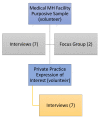Utilisation of Digital Applications for Personal Recovery Amongst Youth with Mental Health Concerns
- PMID: 36554700
- PMCID: PMC9779003
- DOI: 10.3390/ijerph192416818
Utilisation of Digital Applications for Personal Recovery Amongst Youth with Mental Health Concerns
Abstract
There is an increasing population of youths that report mental health issues. Research has shown that youths are reluctant to seek help for various reasons. A majority of those who do seek help are using digital mental health supports. Subsequently, efforts to promote youth mental health have focused on the use of digital applications as a means of overcoming barriers related to factors including stigma and lack of available services. The worldwide move toward recovery-oriented care led to emerging research on personal recovery amongst youths with mental health concerns. This study sought to address the need for recovery-oriented digital resources for youths. It utilised a qualitative design methodology to develop a rich interpretation of how youths are using digital interventions to support their mental health recovery journey. It sought to understand how existing digital applications are useful for youth recovery and identified characteristics associated with recovery and engagement. The content analysis generated five categories that represent facilitators of youth recovery and the thematic analysis identified key elements of digital applications that support youth recovery. The results offer complimentary support and guidance for recovery-oriented care and the use of digital mental health interventions in the promotion of personal recovery amongst youths.
Keywords: digital mental health interventions; personal recovery; recovery colleges; recovery-oriented care; youth.
Conflict of interest statement
The authors declare no potential conflicts of interest with respect to the research, authorship and/or publication of this article.
Figures
References
-
- World Health Organization Adolescent Mental Health. [(accessed on 20 September 2022)]. Available online: https://www.who.int/news-room/fact-sheets/detail/adolescent-mental-health.
Publication types
MeSH terms
LinkOut - more resources
Full Text Sources
Medical




